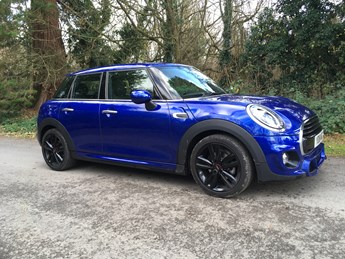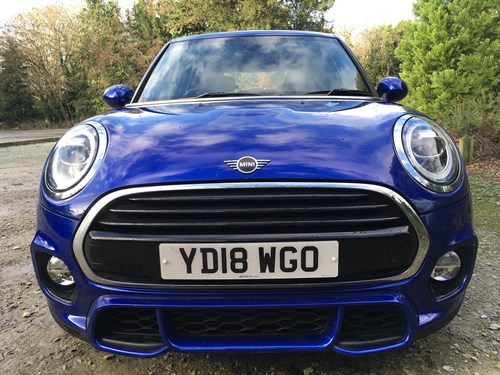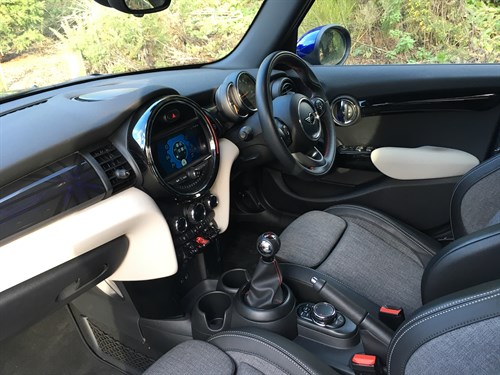We use cookies to ensure that we give you the best experience on our website. If you continue without changing your settings, we will assume that you are happy to receive all cookies on the Business Car website. However, if you would like to, you can change your cookies at any time

The start point for the best source of fleet information |
Final report: Mini Cooper 5-Door Hatch long-term test
Date: 04 February 2019 | Author: Sean Keywood

|
|
||||||||||||
Final Report - A future museum piece?
One of the earliest memories I have of being interested in cars is when my parents took me to the National Motor Museum in Beaulieu, just before my third birthday. It was and still is an impressive place, boasting exotic classics, racers and even Land Speed Record machines (along with a monorail running through the middle, which most toddlers are probably far more interested in). However, for reasons I can't remember, my favourite car from the day was a humble blue original Mini parked in the entrance lobby. It seems serendipitous then that more than a quarter of a century later, having become a motoring journalist, I should be asked to run a blue Mini as a long-term test car. Of course, today's Mini is very different from that one, but could it make as favourable an impression?
Well, the good news is that after six months and more than 8,000 miles, I can report that it certainly wasn't a disappointment to drive. Around town, nippy acceleration and nimble handling made even the plainest shopping trips a hoot. On motorway trips, refinement was good, and despite firmish suspension it was nicely composed at a cruise, which combined with supportive seats meant there was no fear of discomfort on longer journeys. And in all circumstances the slick infotainment control set-up made using the sat-nav and operating the car's sound system a doddle.

After many miles interior trim quality still felt bulletproof, and there were no mechanical issues to report. On the negative side, the badly-placed front armrest was an irritant, and the lack of a collar to lift to engage reverse gear caused me to accidentally lurch backwards at traffic lights a few times. I also never quite got used to the indicators, which are tricky to cancel after changing lanes. More fundamentally, while I enjoyed some of the interior styling touches, such as the retro dials and the aircraft-style rows of switches, I never came around to the more ostentatious elements, such as the Union Jack illuminated dashboard and tail light arrangement, and the projecting Mini logo puddle light - the latter two now being standard features. The John Cooper Works bodykit also feels a bit over the top for a non-hot hatch, though I never lost my appreciation for the black alloy wheels.
As I've written before about our Mini, lots of this comes down to personal taste, and combined with the steep asking price of nearly £25,000 for a supermini, you might be wondering if both problems could be solved by speccing the car differently. There has been news on this front during our test period, as Mini has introduced three new spec levels: Classic, Sport (closest to the John Cooper Works Chili Pack on the car we've been testing) and Exclusive.

To replicate the aforementioned discontinued pack you'd need to opt for Sport spec with the Comfort Pack. Added to the Navigation Plus Pack we've had, which is still available, and the attractive Starlight Blue paint, and leaving out the optional adaptive suspension (which doesn't add much), the total comes to just over £1,000 cheaper than our test car.
It would be possible to save £2,600 by stepping down to Classic and doing without the sports cosmetics, though this also means missing out on cruise control. Going for the standard Navigation Pack saves a further £1,100 but drops the touchscreen from 8.8in to 6.5in and means doing without some live services.
Overall, though, there is indeed room to manoeuvre the spec according to budgets and personal preference. It still won't be a cheap option, but those who love the looks and trendy image can be assured there is substance behind the style. And in general, despite my personal hang-ups, running our Mini has been a pleasure, and I'm sorry to see it go.
5th Report - All right at night?
Having first taken delivery of our Mini at the height of summer, when the days were long and, as you may remember, there wasn't much cloud cover about, it took longer than you might expect before I first drove it in darkness. When I did, it was initially rather startling. Open the driver's door, and a puddle light projects a bright Mini logo onto the pavement. Climb aboard and you'll notice the Union Flag dashboard motif, subtle in daylight hours, is now illuminated in electric blue. Now, this may be a matter of individual taste - and these features do fit in with our Mini's other extrovert styling touches - but personally I'm not a fan, and even among my twentysomething friends opinion is divided.

Once your journey begins, the next thing that comes to attention is the illuminated ring in the centre of the dash around the infotainment screen. This switches between several functions depending on what you're doing at the time, such as lighting up to indicate changing the volume of the radio or adjusting the heating controls, but what is most noticeable at night is that it lights up bright white when you approach a junction if the sat-nav wants you to make a turn. This is a useful feature for those like me, who find voice commands annoying and therefore rely on not missing visual navigation instructions, but I have to confess that when driving in sunlight I simply hadn't noticed it, making tricky routes at night oddly preferable. If this sounds annoying to you, the good news is all of these functions can be customised and switched off if you choose.
One undeniable strong point of the Mini after dark though is the LED headlights. These provide superb illumination, and their automatic function operates faultlessly.
In fact, the lighting setup is so good (including the indicator and brake lights) I even find myself noticing how bright their reflections are in passing street furniture - something I can't remember happening before, and which gives me confidence that other motorists travelling after dark are definitely going to see me coming.
4th Report - Cruising downhill
Cruise control may have been around on some cars since the 1950s, but it's still a must-have feature for many business drivers today. And although the top motorway mile-sloggers are unlikely to opt for a Mini as their company car of choice, it's useful to know it can cut it when necessary in the course of a varied driving routine.
The good news is that our Mini comes with not just cruise control, but cruise control with a braking function. What this means is that while conventional systems can only reduce a car's speed by removing drive from the engine and coasting, the Mini also applies the brakes - not firmly, but enough to slow you down more promptly.

This has several benefits. On a motorway, when approaching a pack of cars doing, say, 65mph, rather than having to press the brake pedal then go through the hassle of re-engaging the cruise, simply reducing the speed selected via the steering wheel control is normally sufficient to slow you down - sort of a halfway house between regular and fully adaptive cruise control. This can also be used when approaching a reduced speed limit section of a smart motorway - taking much of the stress away from roads such as the M25 in particular.
The braking function is also good when the road points downhill. With a regular system cars can 'run away' in these situations and end up exceeding the speed limit, requiring the driver to intervene and brake manually. However, with the Mini's system, in this situation the brake is deployed and a steady 70mph is maintained, even on the steepest sections of dual carriageway - useful given the fondness of the authorities for placing speed traps at the bottom of such sections.
As an added bonus, unlike with some systems, the Mini also allows you to change gear without the cruise being disengaged. This means, should the downhill slope be followed by a steep climb up the other side, you can change down a gear, allowing the system to maintain speed without having to re-engage it. This isn't needed very often though, as the Mini's 136hp engine is plenty strong enough for most requirements.
3rd Report - Taking control
When Mini's parent company, BMW, first introduced its iDrive infotainment system, pairing a multimedia screen with a rotary controller, in 2001, many were sceptical. 'What was wrong with just pressing buttons?', they said - and some would still agree today. However, following the introduction of Apple's iPad a few years later, BMW turned out to have been ahead of the game, as carmakers rushed to equip their own vehicles with tablet-style displays.

The downside with many rival systems is they are touchscreen only, making them difficult to operate on the move. In contrast, while BMW's screen can now also be touch operated - and thanks to the firm's head start on development is one of the sharpest and most responsive on the market - the rotary control is still in place. As fitted in our Mini, it provides the best of both worlds. There's all the convenience of the touchscreen when stationary, but where rivals require you to keep reaching across and jabbing at the screen while driving - which can be tricky and, more importantly, forces you to take your eyes off the road - the rotary control, after not too much practice, allows you to intuitively operate functions you need on the move, like the sat-nav and sound system, with only the occasional glance across. Overall, you spend far more time with your eyes on the road ahead - a real boost for fleets that are rightly worried about driver distractions.
The controller is especially useful in our Mini, as there's plenty to control. With the optional Navigation Plus pack, features include traffic details, Apple CarPlay and Mini Connected. The latter offers news and weather updates, among other things, though these are restricted on the move.

Unfortunately, there's one feature of our Mini the rotary control can't help with - the front-centre armrest. This is also part of the Navigation Plus pack - presumably as it includes a wireless phone charger - and is the most annoying feature of the car. Fold it down, and it gets in the way of your arm when you use the handbrake or gearlever, and if you fold it away, you elbow it when you put the handbrake on. If this was my own car, I'd be tempted to break out a hacksaw.
2nd Report - Mini about town
Although most small cars these days have no trouble handling long motorway trips, if you're considering one as a fleet car it's likely to be with plenty of urban motoring in mind. Happily, in its first few weeks on our fleet, the Mini has made driving around town a pleasure.
Largely, this is because of the low-speed driving experience. The 136hp engine is enough to go 0-62mph in 8.3 seconds, which would have been considered hot hatch performance not so long ago. It means you can really whizz away from the lights, and there's no trouble nipping into gaps in traffic.

Add in highly agile handling - with suspension that keeps the car nicely flat on those tricky roundabouts - and a sports car-like, quick-throw gear change, and even the most mundane shopping trip can be a hoot, with the car seemingly encouraging you to treat the streets of wherever you are like the Monaco Grand Prix track - within safe and legal limits obviously.
Once you get to the shops, there are rear sensors to help avoid any bumps when parking, although a side effect of the squarish retro windows is good all round visibility anyway, while the mirrors, although small, provide a surprisingly wide field of view. And although the boot, at 278 litres, may be smaller than some supermini rivals, it should be enough for most grocery shops. If you do buy too much, the advantage of having the five-door model is it's easy to place any extra bags on the back seats.
The only thing to watch out for is when you pull away. There's no collar to lift on the six-speed manual gearbox to engage reverse gear - you just firmly push the lever all the way to the left. The advantage is it's quicker to select reverse when manoeuvring, but the downside is if you forget and go for first in a hurry you could end up shooting backwards by mistake. I've only done this once so far and caught it on the brakes quickly, but what the people behind me at the traffic lights must have thought, I dread to think.
1st Report - Mini makes a big entrance
Since the first BMW Mini was introduced in 2001, it's always been a supermini with a strong emphasis on style. And if you didn't already know that, it likely wouldn't take more than a few seconds with the newest member of our long-term fleet - one of the recently facelifted third-generation models in Cooper 5-Door Hatch form - before you did.
Approach from the front, and you'll notice the distinctive new headlight design, with the daytime running lights forming a ring around the main headlight. Approach from the rear and things are even more distinctive, as the light cluster has been arranged in a Union Flag shape. Then climb aboard, and you'll find eye-catching touches like the overlapping, steering column-mounted retro speedometer, rev counter and fuel gauge, rows of metallic, flight deck-style switches and a large circular ring around the infotainment screen that lights up in different colours depending on what functions are enabled.

And that's only talking about standard equipment. Add in the options our test car has come loaded with and things get even more modish. Like the John Cooper Works Chili Pack, which adds exterior features such as a rear spoiler, bodykit and 17in black alloy wheels, with the latter a personal early favourite. This pack also adds a John Cooper Works-branded steering wheel and door sills, and a feature where the Mini logo is projected from the driver's door mirror onto the pavement - which caused me to double-take the first time I unlocked the car at night. Our car also has the Navigation Plus Pack fitted, which ups the screen to 8.8in, and includes, among other options, an illuminated Union Flag motif on the dashboard in line with that on the rear lights.
Add all this together - in combination with the eye-catching Starlight Blue paint - and the overall effect isn't subtle. Put it this way - if you're a private investigator, or a funeral director, or have any job where discretion is required, then this probably isn't going to be the company car choice for you. But if you're OK with a bit of razzmatazz and are just hoping to stand out in the office car park, then it's mission accomplished. And even though my personal tastes tend towards the more discreet, I can't deny that when our Mini first rolled off the transporter it made quite an impression - it'll be interesting to see if it wears off at all as the months pass.

Under the bonnet, the Cooper has a 1.5-litre 136hp petrol engine, which sends drive to the front wheels via a six-speed manual gearbox. In official tests, this achieves a combined fuel economy of 51.4mpg and of course it will be interesting to see how close our car can get to this figure during our time with it.
Along with a reputation for style, Minis are also known for being good fun to drive, and that's something else I'm keen to test - particularly with the optional adaptive suspension fitted. Another expectation is a high level of build quality, and that certainly rings true on first impressions - everything inside feels very solid. Of course, time will be the judge of that.
The only early note of caution concerns something you may have noticed a lot of so far - optional equipment. This does have an impact on cost. From a basic P11D of £17,825, the extras fitted to our Mini take it close to £25,000, which however you shake it is a lot for a supermini, even a premium one. Can it make sense to pay that much? Well, that's another thing I'm looking forward to finding out over the coming months.












